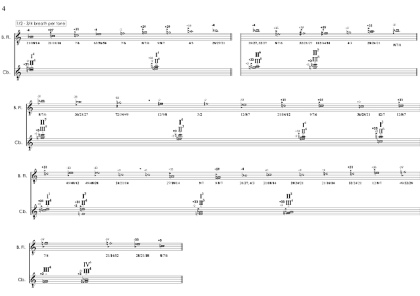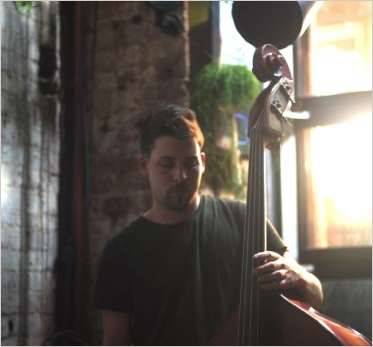Another Timbre TimHarrisonbre

at173 Catherine Lamb ‘Muto Infinitas’ (2016/18)
Rebecca Lane (quartertone bass flute)
Jon Heilbron (double bass)
A 50-minute duo composition for quartertone bass flute and double bass, recorded in Andreaskirche, Berlin Wannsee in April 2019 by Adam Asnan.
CD copies now sold out, but downloads are available from our
Commentary on ‘Muto Infinitas’ by Rebecca Lane
I have been slowly working on Muto Infinitas for 5 years (!) and it charts a large part of the development of my personal and musical life with Cat Lamb, and a personal practice in playing extended just intonation (or as Cat would prefer to say, rational intonation). Jon Heilbron and I consider this piece to be a work in progress – so it is in this spirit that we offer the recording.
The piece is an example of Cat’s interest in the long introduction, which she expands harmonically and melodically over time. She mentioned to us that her hope was to create the perceptual experience where a melody emerges but the listener is not aware at which point it begins to do so.
The piece is unmetered – the double bass, as a sustaining instrument, follows the voicings of the flute, whose gradually diminishing breath lengths generate the movement from harmony to melody over around 60 minutes. However, it’s an ambiguous zone between harmony and melody, consonance and dissonance, the individual timbre of our instruments and their timbral fusion.
We have made various formal and informal recordings of the piece over the years, which have helped to shape our interpretation of it. Attending to the interaction of the ratios (relative stasis) but also being responsible for illuminating the whole form (movement forward) through the placement of my tones/breath lengths is a constant negotiation that forces me to contemplate the micro and macro / vertical and horizontal aggregates simultaneously. (Though Cat has reminded me that the material is such that it exhibits multiple dimensions beyond simply the vertical and the horizontal.)
I can easily get lost in tuning the ratios, in discovering the nature of their interactions and internalising their aural picture. Listening back to a recording helps with refining the acoustic clarity of the ratios, but it also helps in perceiving the total form from the outside. Re-threading the piece, through the editing process, gave me the opportunity to perceive the total form, to see how we might change the way we play it live in order to unfold the perceptual space that Cat is seeking. So the piece is a framework into which Jon and I hope to go deeper and deeper. We look forward to performing it again and again and seeing how our interpretation and listening evolve further.
The origins of the piece lie in 2016 when Cat, Mike Majkowski and myself received a small grant for Cat to develop a piece with us. Muto Infinitas gradually took shape over around a year; Mike and I met with Cat once or twice a month and each time she would bring the next section of her piece, which we would workshop together. Cat’s working process is never dogmatic or pedagogical, and she gave us space to find our own way into the material. The development period and first performance was with Mike, then in 2017 Jon and I began to work on it together and have performed it a handful of times since then.
Cat wrote Muto Infinitas for my Eva Kingma quartertone bass flute which I had just bought at the time, and through the piece we discovered its microtonal capabilities. I never play it as an equal temperament quartertone instrument, but the extra keys are paramount because they increase the instrument’s microtonal flexibility. I find the fingerings that get me closest to a particular frequency and then move closer to it using vowel formants, air speed and embouchure – techniques I began to develop while working on the piece. I like to think of myself as a frequency producer rather than a flute player, finding freedom through numbers – Cat’s scores often indicate ratios, cents, frequencies or partial numbers. Re-approaching melodic material from this angle helps me to put aside the historical baggage of my instrument and find pleasure in melody again.
Cat and I first met in 2013 when a mutual friend, artist-poet Natalie Häusler, suggested I meet her. I realised that I had already seen Cat perform with others (Johnny Chang being one), and had had the strong intuition (which doesn’t happen often!) that I should play with her. We finally met in the toilets at Ausland – I guess we were immediately comfortable! The following year I played a piece of hers called Frame, also for bass flute, and it was a turning point for me. I realised that you could actually focus your musical imagination on acoustic perception, on the inner nature of tonal relationships – an aspect that had been a fleeting experience in the music I had played up until that point. I admire Cat greatly because her approach to composing is intuitive and rigorous but, put plainly, it is also deeply joyful, as is her warmth and generosity in sharing her knowledge of the material.

Page from the score of ‘Muto Infinitas’

Rebecca Lane

Jon Heilbron